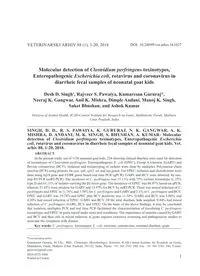
2018 Molecular detection of Clostridium perfringens toxinotypes, Enteropathogenic Escherichia coli, rotavirus and corona PDF
Preview 2018 Molecular detection of Clostridium perfringens toxinotypes, Enteropathogenic Escherichia coli, rotavirus and corona
. 1 ISSN 0372-5480 Printed in Croatia VeterINarSkI arhIV 88 (1), 1-20, 2018 Molecular detection of Clostridium perfringens toxinotypes, Enteropathogenic Escherichia coli, rotavirus and coronavirus in diarrheic fecal samples of neonatal goat kids Desh D. Singh#, Rajveer S. Pawaiya, Kumaresan Gururaj*, Neeraj K. Gangwar, Anil K. Mishra, Dimple Andani, Manoj K. Singh, Saket Bhushan, and Ashok Kumar Division of Animal Health, ICAR-Central Institute for Research on Goats, Makhdoom, Farah, Mathura, Uttar Pradesh, India ________________________________________________________________________________________ SiNGh, D. D., R. S. PAwAiyA, K. GuRuRAj, N. K. GANGwAR, A. K. MiShRA, D. ANDANi, M. K. SiNGh, S. BhuShAN, A. KuMAR: Molecular detection of Clostridium perfringens toxinotypes, Enteropathogenic Escherichia coli, rotavirus and coronavirus in diarrheic fecal samples of neonatal goat kids. Vet. arhiv 88, 1-20, 2018. ABSTRACT In the present study, out of 1156 neonatal goat kids, 238 showing clinical diarrhea were used for detection of toxinotypes of Clostridium perfringens, enteropathogenic E. coli (ePeC), Group a rotavirus (GarV) and Bovine coronavirus (BCV). Isolation and toxinotyping of isolates were done by multiplex Polymerase chain reaction (PCr) using primers for cpa, cpb, cpb2, etx and iap genes. For EPEC, isolation and identification were done using bfpa gene and SYBr green based real time PCr (qPCr). GarV and BCV were detected, by one- step rt-PCr (osrt-PCr). the incidence of C. perfringens was 15.13% with 75% isolates toxinotype a, 25% type D and 61.11% of isolates carrying the β2-toxin gene. The incidence of EPEC was 68.07% based on qPCr, whereas 21.85% were positive for GarV and 15.97% for BCV by osrt-PCr. there was mixed infection of C. perfringens and ePeC in 11.76% and 3.78% for C. perfringens and GarV and 2.1% of C. perfringens and BCV. ePeC and GarV was 19.74% and ePeC plus BCV positivity was 11.34%. GarV and BCV was 5.88%, and 4.20% had mixed infection of ePeC, GarV and BCV. Of the total diarrheic kids sampled, 0.84% had mixed infection of C. perfringens, GARV, BCV and EPEC. On the basis of the above findings, it may be concluded that isolation, multiplex PCr and real time PCr facilitated the characterization of circulating C. perfringens toxinotypes and ePeC in goats reared under semi-arid conditions. the importance of enteritis caused by GarV and BCV and their role in mixed infection in goats requires extensive screening and pathogenicity studies to associate the symptoms with disease. Key words: C. perfringens; toxinotypes; E. coli; rotavirus; coronavirus; neonatal diarrhea; goats ________________________________________________________________________________________ *Corresponding author: kumaresan Gururaj, M.V.Sc., PhD., (Veterinary Microbiology), Scientist, ICar-Central Institute for research on Goats, Makhdoom, Farah, Mathura (Uttar Pradesh) 281122, India, Phone: +91 565 2763 380; Fax: +91 565 2763 246; e-mail:
